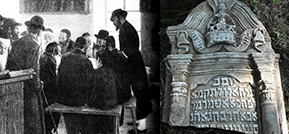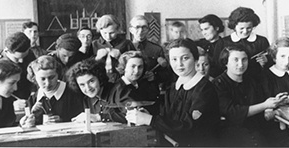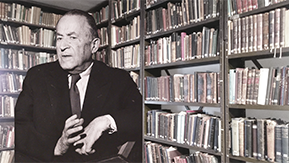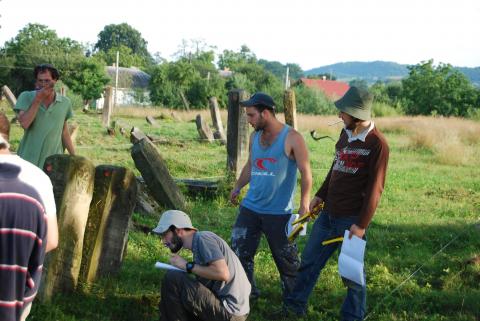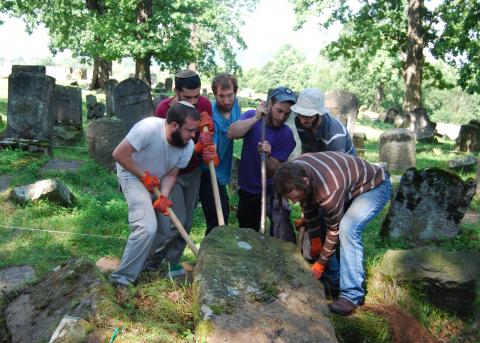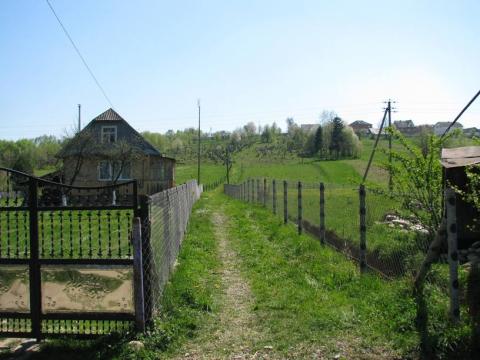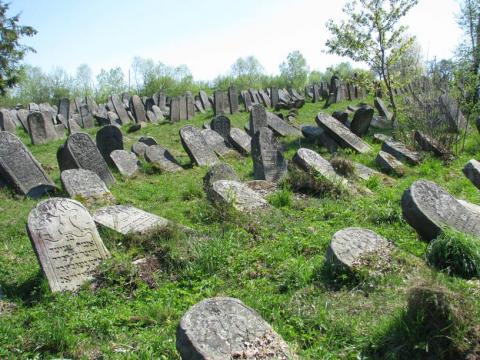Prepared by Dr. Maria Kaspina, Dr. Boris Khaimovich & Dr. Vladimir Levin
Not a single taxi driver in Ivano-Frankivsk knows where the synagogue is located, although its massive building stands only 50 meters away from the central square bustling with people at its shops and restaurants. The once vibrant Jewish community of Eastern Galicia, numbering half a million people, was not only eradicated by the Nazis and their supporters during the Holocaust, but it has also faded from the memory of local inhabitants. The aim of our field school and the entire Jewish History in Galicia and Bukovina project is to document, collect and revive remnants - physical as well as intangible - that can still be recorded, preserved and revived after 65 years of Jewish absence from the region. Towards this aim, the Second Field School arrived at Ivano-Frankivsk (formerly Stanisławów) during the summer of 2010.
The Second Field School in the Ivano-Frankivsk Region took place from July 21 to August 10, 2010. It was organized by the Jewish History in Galicia and Bukovina project and the Moscow Center for University Teaching of Jewish Civilization Sefer. Fifteen students under the guidance of five scholars engaged in the documentation of Jewish history. The school was composed of three teams: one documenting Jewish cemeteries, another recording oral history and ethnographical materials from the local residents and the third team surveying towns and villages in the region.
The complex approach applied towards the remnants of Jewish history allows for exploration in the fullest possible way. We are working in the region where Jews have been absent for 65 years and the vast majority of Jewish cultural heritage has disappeared without a trace. The majority of Jews, the keepers of local tradition, were cruelly exterminated during the Holocaust; most of those who survived emigrated to Israel and the United States. The number of people, both Jewish and non-Jewish, who remember the period before WWII, is very small and continues to diminish. Hundreds of synagogues and prayer houses were destroyed; those that survived were changed completely, sometimes preserving only basic architectural features such as the arrangement of windows. Dozens of Jewish cemeteries were wiped out and the tombstones used as building material. Books and manuscripts, photographs and artifacts didn't survive WWII and beyond.
We are trying to collect what can be still found in situ. The tombstones in Jewish cemeteries are a perfect example of local Jewish artistry, the other expressions of which largely being lost. Their epitaphs are clear evidence of the literary culture of the local Jews - for a long time the only literate population in the region. The documentation of the tombstones "revives" generations of Jews buried in the surviving cemeteries.
Oral recollections of living Ukrainians help to shed light on the everyday life of the Jewish population before the Holocaust and attest to the widespread coexistence in this once ethnically mixed region. Interviews with elderly local inhabitants also revitalize the memories of Jews and draw the attention of younger generations who never saw Jews in their towns and villages.
Archival research flushes out documentary evidence of Jewish life. Due to the nature of local archives, which mainly contain the paperwork of state institutions, archival documents reflect the interaction of Jewish communities with governmental agencies (the archival work in our project is conducted through the Central Archives for the History of Jewish People in Jerusalem). Several years of intensive work to collect remnants of Jewish life in the region will provide the scholarly community and those interested in Jewish and family history with the fullest possible range of information.
I. Jewish Cemeteries
A team headed by Dr. Boris Khaimovich from the Hebrew University of Jerusalem and Ms. Marina Bruk from the European University in St. Petersburg documented four Jewish cemeteries: Nadvirna (Nadwórna), Lysets (Łysiec), Burshtyn (Bursztyn) and Rozhniativ (Rożniatów). All four cemeteries are interesting examples of the diverse local burial tradition.
The cemetery in Nadvirna (Nadwórna) is only partially preserved and is used by the local population as a place for drinking alcohol and other such activities. It is covered with very dense vegetation and piles of litter which severely impede efforts for documentation at this cemetery. Many tombstones have been uprooted and thrown into piles, which also complicated access for the researchers. Only after preparatory work of clearing the vegetation and disassembling the piles of tombstones, the team was able to document 530 tombstones, which were numbered, photographed, measured and their epitaphs transcribed.
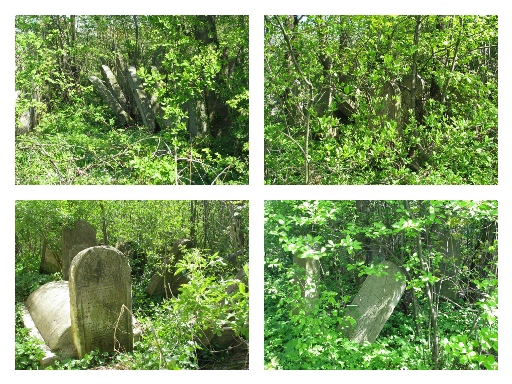
General landscape of the cemetery in Nadworna
The oldest tombstone in this cemetery is dated ת"ט) 1649) - dating it to the time of the Chmelnitsky massacre of 1648-49. This tombstone of Issachar Ber, son of Haim, is the oldest evidence of a Jewish presence in Nadvirna and it may testify to the first Jewish settlers in the region being refugees from areas affected by the Cossack rebellion. This tombstone is very similar to the oldest tombstone in the cemetery of Solotvyn (dated 1665), documented by the first field school in 2009. The epitaph on the tombstone in Solotvyn states that the deceased is a son of holy Yehezkel Segal, i.e. that Yehezkel was killed by non-Jews, most likely during the Chmelnitsky massacre. Both tombstones, in Nadvirna and Solotvyn, are the earliest evidence of a Jewish presence in the region and demonstrate a connection to the greatest catastrophe in Eastern European Jewish history before the 20th century. Unfortunately, other tombstones of the 17th century are not preserved. From the 18th century, only two gravestones were preserved by chance: one from 1774 and another from 1777.
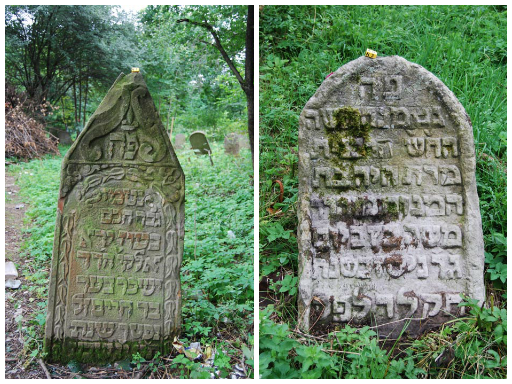
Oldest tombstones in the Jewish cemetery of Nadworna
The most important area in the Nadvirna cemetery is around two ohalim (small buildings above the graves) of the Nadworna Hasidic leaders. The older one, made in an unusual barrel form, covers the graves of Rabbi Tsvi Hirsh and his family; the second one covers the graves of Rabbi Issachar Ber and his descendants.
During the entire 19th century, Nadworna was one of the most important Hasidic centers in Galicia and attracted thousands of Hasidim throughout the region. The importance of the Nadworna Hasidic court can be clearly seen in the area adjacent to the ohalim. Several dozen people from the renowned Hasidic families are buried there, among them a great-grandson of Rabbi Levi Itshak from Berdichev, a grandson of Rabbi Haim from Czernowitz, a daughter of Rabbi of Halych R. Shmuel, a great-granddaughter of Maggid of Zlochev and others. The tombstones of the prominent Hasidim who played distinguished roles at the Nadworna court can be also found around the ohalim.
Approximately one hundred tombstones were discovered in large piles of stones near the ohalim. They also belonged to members of notable families and were crafted in a high level of artistry.
Other areas of the cemetery date to the second half of the 19th century and to the period between the World Wars. They are simple in design, with typical depictions marking difference between graves of women and men. Some tombstones, uncovered from the earth, preserved the original colors from the interwar period. The most recent gravestone dates to 1940, after the region was occupied by the Soviet Union.
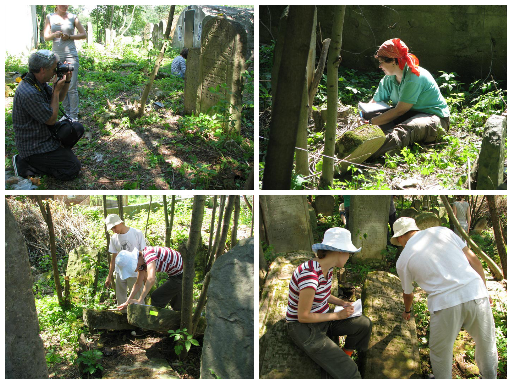
working in the cemetery
The cemetery in Lysiets (Łysiec) is home to 220 tombstones and our team documented it completely. It is a good example of a well-preserved cemetery of a small rural community in the Carpathian region. The graves of local rabbis are situated in the middle of the graveyard. The majority of the tombstones are dated to the 19th and 20th centuries. Some depictions from the turn-of-the-century combine traditional folk images with a provincial modernist style. Six Jews were murdered by the Nazis at the cemetery's fence; no memorial sign exists there.

Selected decorations from tombstones in Lysiec
In Burshtyn (Bursztyn) only one-eighth of the original cemetery is preserved, numbering 333 tombstones; the other tombstones were used for paving the road to Lviv. The remaining, mainly women's tombstones are concentrated in one block, in 25 dense rows. Only several of the men's tombstones are preserved. Despite the relatively widespread custom of assigning different plots to male and female burials, a strict division between genders is rare. The presence of the important and conservative Hasidic court of Rabbi Nahum Brandwine in the town likely caused this phenomenon. This cemetery presents an amazing collection of the most widespread Jewish symbol for women's gravestones in the 19th-20th centuries - the Shabbat candelabra. Among 333 preserved tombstones, there are no two similar candelabra; each one is different.
The most interesting cemetery among those documented this year is in Rozhniativ (Rożniatów). The oldest part of the cemetery, dating to the 17th century, is surrounded by an earth wall. This arrangement was very common in East-Central Europe and led to the Polish and Ukrainian term for Jewish cemeteries: okopyśko/okopyshche, meaning a territory surrounded by an earth wall. However, the earth walls surrounding such cemeteries are preserved in only very rare instances and that the Rozhniativ wall in such a good condition is quite unique.

The cemetery in Rozhniatov

Tombstones from Rozhniatov cemetery
The area surrounded by the wall served for burials from the late 17th century (1687) until the early 19th century (1817). The shape of the earliest tombstones and their script are very similar to the tombstones of the same period in Central Europe and differ significantly from the tombstones in Nadvirna and Solotvyn. The tombstones from the 18th century bear the same images of animals as the stones in the most important Jewish cultural centers of Eastern Europe. In other places in the Ivano-Frankivsk region, only rarely are 18th-century tombstones preserved.
In the oldest part of the cemetery, a stone marking the genizah from the early 20th century was found. It mentions five Torah Scrolls which perished in a fire. Gravestones of gnizot are a rare phenomenon in Jewish cemeteries of Eastern Europe. This one bears a depiction of an open Torah ark.
During the cholera epidemic of 1831, the community began to bury its dead outside the old walled cemetery. Around a dozen tombstones are dated to Tamuz 5591 (April 1831) - the time when cholera spread in Rozhniativ. The memory of the cholera period is kept among the local people up until today. After the end of the epidemic, the community continued with burials outside the earth wall. Our team succeeded to document almost all tombstones of the 19th century, comprising 360 items. Many of these are decorated with local style images. The gravestones from the 20th century are situated in a forest which grew there following WWII. Local youth uses these tombstones as places of "romantic" meetings.
II. Collecting Oral History
The team headed by Prof. Olga Belova, of the Institute for Slavic Studies of the Russian Academy of Sciences, and Dr. Maria Kaspina, of the Russian State University of the Humanities in Moscow, collected oral history and ethnographic testimonies from local residents, both Jewish and non-Jewish.
As determined during the previous field school last year, operating in the same town as the cemetery team is very productive. Activity at the Jewish cemetery draws the attention of local residents; they come to the cemetery and begin to share their recollections about Jews. The simple act of "Jews" (despite the fact that the majority of students in our team are not Jewish) coming to their cemeteries, cleaning and researching them, stimulates the memory of the local population and encourages them to speak about Jews. At this point, the oral history team has a wonderful opportunity to collect and record this information. Therefore, a unique picture of Jewish history in a given town takes shape - earlier periods are reflected in the tombstones, while the pre-war years and the Holocaust are expressed by the memory of living people.
We are collecting oral testimony at the last moment. Elderly people who indeed remember Jews in a given town are now very rare and their number is diminishing daily. In addition, post-war migrations led to an influx of the Ukrainian population from other villages and regions, making them a majority in these former Jewish-Polish towns; therefore, this population is alien to local tradition, has never seen local Jews and has no memories about them.
While in-depth research was conducted last year in Solotvyn and Nadvirna, efforts of the ethnography team this year were concentrated in Burshtyn. A dozen people living in the area adjacent to the Jewish cemetery were interviewed, especially concentrated on the street which before WWII was named after Theodor Herzl and now is named after Russian revolutionary and writer Alexander Herzen. The team also worked in Lysiets, where interesting information was recorded from the people living next to the Jewish cemetery and in Rozhniativ, where a descendant of local Jews was interviewed. The team also visited Kalush, Kolomea, Otynia, Chernelytsia, Verkhovina and Ternopol. During the 2010 field school, we used as a basis the questionnaire developed by the previous field school. This questionnaire, which in and of itself is an import result of the mission, will be improved using the experience of the current field school.
During the collection of oral history, the recollections of shabes-goim (Christian children who were invited by Jews to light fire on Saturdays) were recorded in many places. Also, stories about Jewish holidays were recalled, including memories of Christians receiving matza from Jews and giving their neighbours Easter cakes in return. Several common stereotypes about Jews recorded last year were reconfirmed during this field school. The most widespread misconception is that Jews are buried in a sitting position. One explanation given by interviewees is the lack of space in the Jewish cemetery. Another one, no less "rational," relates that burial in a sitting position allows Jews to stand up quickly at the time of resurrection before the Last Judgment.
Another widespread belief held by the local non-Jewish population involves a prikazanne - "commandment." Usually this relates to a mezuzah parchment, but it could also be a part of a Torah scroll, parchment from phylacteries or any text in Hebrew letters. Many magic rituals, especially in Ukrainian folk medicine, are connected to prikazanne. For example, the burning of prikazanne is said to help with epilepsy.
During this field school we also often worked with local Jews, despite the fact that majority of these Jews came to the region after WWII from other areas. We were able to speak with communal leaders and document the current situation of the community. This information adds a significant layer to the findings gathered in the neighboring regions of Bukovina, Bessarabia and Podolia. In all these regions, it is customary that the Ukrainians come to Jewish people - to synagogues, cemeteries and even individual Jews - for help, considering that the Jewish religion is "closer to God." Evidence of such appeals is recorded by non-Jews as well as by Jews themselves. For example, Ukrainians come to a Jewish woman living in Rozhniativ - a rare case of a Jew in the village of today - and ask for Jewish texts for "commandments;" she even provides them with such texts from Israel. In the places where functioning synagogues exist, we documented an institutionalized practice whereby Ukrainians make donations to the synagogue in exchange for a prayer for their health and wellbeing.
Due to the treatment of Jewish texts as a powerful magical aid, and the consideration of everything Jewish as a mighty power since "the Jews are first by God," the tradition of asking Jews for help has been preserved even after 65 years of Jews being generally absent from the region.
III. Survey of Jewish Monuments
A small team led by Dr. Vladimir Levin, of the Hebrew University of Jerusalem, continued its efforts from last year of surveying towns and villages where Jewish monuments remain. This year, the team visited those areas which were omitted last year due to lack of time.
In the village of Bukachevtsy, a ruin of a synagogue and the area of a Jewish cemetery were found. The tombstones from the cemetery were used in the 1950s to pave the sidewalks. Since the inhabitants of the village do not need sidewalks along unpaved streets, they gradually removed these tombstones and threw them away.
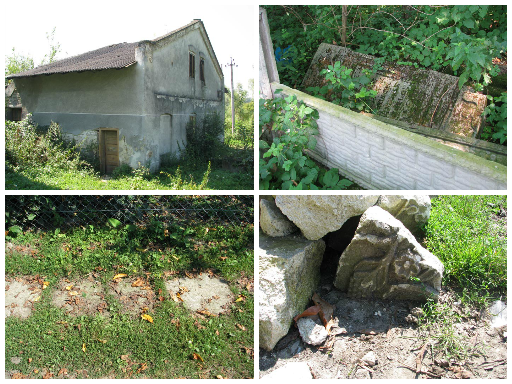
Remanents of the Jewish community in Bukachevtsy. Top left: the Synagogue. Buttom left: a sidewalk from old tombstones. On the right: The Jewish Cemetery
Chernelytsia village was once a thriving town with an important castle. Today, only a ruin of a synagogue and remnants of several tombstones serve as reminders of its Jewish population. All Chernelytsia Jews were murdered near the village Mikhalche, where the Jews from Horodenka perished as well. The mass murder was performed on the banks of the Dniester River and today a youth resort stands in this picturesque setting. In Horodenka, the team visited the old Jewish cemetery with tombstones from the 17th and 18th century and found it surrounded by piles of garbage.

Ruins of the synagogue in Chernelytsia Remnants of the Jewish cemetery in Chernelytsia
In the quaint town of Sniatyn, the former synagogue was converted during Soviet times into a clothing factory. In one of the houses on the market square, the team was shown a hatch in a ceiling which served the Jewish inhabitants during the Sukkot holiday. The hatch was opened and the area under it served as a sukka. In Zabolotiv, the team found the Jewish cemetery situated between private homes and the building of the former beit midrash.

Cemetery in Zabolotiv Former beit midrash in Zabolotiv
In the town of Bibrka, which lies in the road from Ivano-Frankivsk to Lviv, the team photographed the ruins of the synagogue. The structure stood abandoned since the collapse of the Soviet Union and the closure of a food factory situated in this building.
The team also visited the village of Verkhovina, formerly known as Zhabye. It is situated high in the Carpathian Mountains. A building which served as a prayer house is preserved there, as well as several Jewish houses in the vicinity. A small Jewish cemetery and a memorial sign at the site where the Verkhovina Jews were murdered are located in the village of Il'tsi.
In the famous mountain spa of Vorokhta, the team discovered the Sanatorium of Jewish Academics - a health resort for Jewish students from Lviv, where treatment against tuberculosis was provided. It was built in the early 1930s by the Jewish architect from Lviv, Jósef Awin (1883-1942), in the International style. This elegant building is still used as a sanatorium and its architecture remains almost unchanged.
The team was not able to visit the villages of Tatariv, Mikulychyn, Yaremche and the town of Deliatyn because the road was blocked by a heavy muddy flooding, which caused significant destruction.
IV. Educational Program
The field school offered an impressive educational program. Beyond instruction given during the documentation work, the students were offered educational trips and lectures. The first such educational trip journeyed east. The group visited Buchach (Buczacz) - the birthplace of Shmuel Yosef Agnon; Hrimailiv (Grzymalów) with its ruined synagogue from the 18th century; and Sataniv (Satanov), where an amazing Jewish cemetery and a synagogue from the early 17th century are preserved. In Buchach, the group visited the 18th-century Jewish cemetery, now heavily used by local drug addicts and was shown Jewish tombstones found during the repair of a road in the town.
The second educational trip ventured south to the Carpathian Mountains. The group visited the village of Kolochava with its 17thcentury wooden church and an ethnographic museum where a Jewish prayer room and a Jewish inn are reconstructed. Lectures by Dr. Khaimovich on Jewish history in Galicia in the Early Modern period and by Prof. Nosonovsky on Jewish tombstones were given at the ruins of the Buchach castle. Lectures by Dr. Levin on Moorish synagogues and by Dr. Khaimovich on synagogues' interior decorations were given in Ivano-Frankivsk. In addition, the ethnography group held evening seminars where the information gathered during the day was discussed under the guidance of Prof. Belova and Dr. Kaspina.
Heads of the Field School:
Prof. Olga Belova, Moscow
Marina Bruk, St. Petersburg
Dr. Maria Kaspina, Moscow
Dr. Boris Khaimovich, Jerusalem
Dr. Vladimir Levin, Jerusalem
Anna Shayevich, Moscow
Participants of the Field School:
Svetlana Amosova, St. Petersburg
Michael Beketov, Moscow
Michael Bessmertnyi, Kiev
Kirill Danilchenko, Kiev
Natalia Evseenko, St. Petersburg
Olga Gushcheva, Minsk
Elena Kolomyets, Kiev
Ekaterina Lazareva, Moscow
Alesya Nekrasova, St. Petersburg
Prof. Michael Nosonovsky, Milwaukee, WI
Alexandra Pavlova, St. Petersburg
Anna Tokhtasyeva, St. Petersburg
Michael Vasilyev, Moscow
Natalia Vasilyeva, St. Petersburg
Ilya Yuzefovich, Moscow



